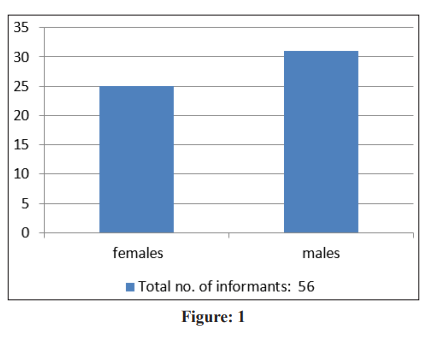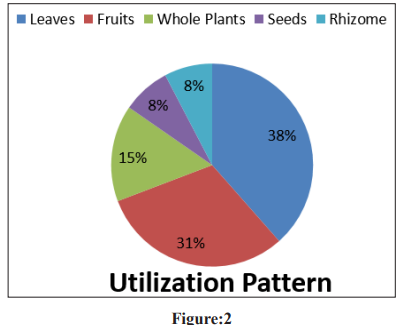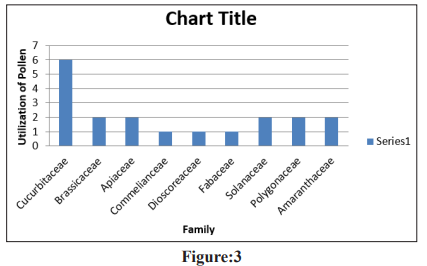Author(s): Tahir Mahmood*, Adil Farooq
The analysis of edible vegetables used by nomadic community Pir Panjal region of district rajouri Union territory Jammu & Kashmir-India The present investigation of edible vegetables were based on extensive and intensive field survey during January 2020 to January 2021. A total of 24 edible vegetables species belonging to 18 families have been reported from the areas. The inventory is expected to provide baseline, scientific data for further Studies on edible vegetables and can be used to facilitate the long-term conservation and sustainable uses of medicinal resources in the Union territory of Jammu and Kashmir. Cucurbitaceae was found to be most dominant families in term of the species in the areas with 3 species, followed by Malvaceae and Rosaceae.
Consuming edibles is part of the food habits of people in many societies and intimately connected to virtually all aspects of their socio-cultural, spiritual life and health. It also plays a major role in meeting the nutritional requirement of the nomadic population in remote parts of the country throughout year. India is one of the second largest human populations in this planet 75% of the population is living in the rural areas, which depends upon wild edibles plants. Wild plant species have been used worldwide over many years as part of human diet. Several Studies dealt with the identification and classification of wild edibles including vegetables. Edible plants are major source of food for nomadic inhabitants in forests. Edible parts of wild plants (fruits, flowers, leaves, tubers, inflorescence, roots, tubers, rhizome, etc.) are the nature’s gift to mankind; these are not only delicious and refreshing but also the chief source of vitamins, minerals and proteins [1]. About 1,000 species of these plants provide sustenance to nomadic inhabitants in India. In many parts of the world, edible plants are reported from forest, designated for extractive resources and managed by local communities for their own and other purposes. Food plants serve as alternatives to staple food during the period of food deficit are a valuable supplement for a nutritionally balanced diet and also one of the primary alternative sources of income for many rural and nomadic communities Earlier, plants and their uses have been explored by several plant explorers in western Himalaya [2-14].
The aim of the current research is to highlight the key of medicinal uses of edible vegetables by nomadic community of Pir Panjal region of district rajouri Jammu and Kashmir (Ut) India.
The present study was accomplished to document of the medicinal uses on the edible vegetables of Pir Panjal region of district Rajouri, State Jammu and Kashmir India, it is located at southern part of Jammu division in the foot hill of Pir Panjal range between 32°-58′ and 33°-35′ latitude and 74°-81′ longitude at an elevation range of 370-6000 msl, It is bounded on the eastern side by district Reasi Western side by Pok, Northern side by District Poonch it is about 915,m above the sea level . Covering an area of 2630 sq.km, and as population of 6, 19,266 per 2011 census [15].The present communication pertains to wild edible vegetables were collected from of Pir Panjal region and adjoining area of district rajouri State Jammu and Kashmir India, and were identified with the help of local flora of Udhampur [15-21]. General information about the medicinal uses of edible vegetables was collected from the local peoples. About 52 local peoples respondents including both male and female was interviewed. The question about the indigenous uses of medicinal uses of edible vegetables species were asked in Urdu, Gojjri & Phari. Plants specimen collected from the area were dried, pressed and mounted on herbarium sheets.
A systematic and extensive ethno-botanical survey was carried out in different villages of the district rajouri of Pir Panjal region during January 2020 to January 2021. For the collection of information on edible plant species being used by locals in the study area. Before initiating the present study, a detailed survey was conducted during which various villages were visited and information was gathered about the people having the knowledge of edible plants or those involved in collection and sale of theseplants. During the survey, informants were selected randomly and information was gathered by conducting interviews and group discussions with the informants in their local language on the indigenous uses of wild flora as food. A total of 52 informants (25 females and 31 males) between the age group 15-75 years were interviewed with a questionnaire. The information collected included common wild edible plant species, local name of plant species, habit, flowering time, plant part used, and recipe prepared individually or in combination with other plants. The specimens of plant species were collected from the study site and then identified from the herbaria of the Department of Botany, University of Jammu, and Baba Ghulam Shah Badshah University Rajouri, and also with the help of various regional floras [43, 44].The final list of the plants was prepared following the International Plant Names Index (http:// www.ipni.org) and Tropicos (2017) for the botanical nomenclature of species. Correct identified herbarium data were deposited in Centre of Biodiversity Studies, BGSB University rajouri for future reference.
A total number of 24 plants species belonging to 18 families were identified which are being used by nomadic community of Pir Panjal region of district rajouri Jammu & Kashmir -India. A total of 52 informants (25 females and 31 males) between the age group 15-75 years were interviewed with a questionnaire (figure 1). The data collected are arranged in alphabetical order of the species name, family name, Local name, Habit, parts used mode of uses and their medicinal uses given for each species (Table 1). The use pattern of the species indicated that fruits, seeds, roots, leaves and whole plants are used in (figure 2). The results of the study showed that Cucurbitaceae is the largest medicinal plant family (figure 3). The values and characteristics of family, Curcurbitaceae as a Predominant in this area, among all the families Cucurbitaceae were found to be most dominant families in term of the species in the area with (6) species, followed by Polygonaceae and Brassiceae. Edible parts of vegetables (fruit, leaves, tubers and rhizomes) are the nature gift to mankind. The edible vegetables are the normal food of cattle grazers and the forest tribes. These are not only delicious and refreshing, but also the chief source of vitamins, minerals and proteins.
| S. no. | Botanical name | Family | Local name | Voucher number | Habit | Part | EV | Medicinal uses |
|---|---|---|---|---|---|---|---|---|
| 01 | Amaranthus viridis L. | Amaranthaceae | Ghanar | 2021 | AH | Leaves | Vegetable | The nomadic peoples used the leaves as vegetable to treat Jaundice. |
| 02 | Braccia campestris L. | Brassicaceae | Sarson | 2022 | AH | Leaves | Vegetable | The peoples used the leaves as vegetables to treat constipation |
| 03 | Coriandrum sativum L | Apiaceae | Dhania | 2023 | AH | Whole Plan | ||
| 04 | Cucurbita moschata L. | Cucurbitaceae | Aal | 2024 | AC | Fruit | Vegetable | The peoples used the vegetable to treat diuretic |
| 05 | Commelina benghalensis L | Commelianceae | Angaero | 2025 | AH | Leaves | Vegetable | The people used the leaves as vegetable to treat stomach. |
| 06 | Daucus carota L | Apiaceae | Gaajer | 2026 | AH | Whoe Plant | Vegetable | The people used the whole plant in vegetable for 2-3 weeks to treat Ulcers. |
| 07 | Dioscorea alata L | Dioscoreaceae | Tar gi be | 2027 | AC | Rhizome | Vegetable | Roots cooked- usually boiled or baked and used as a vegetable to treat Mouth sores |
| 08 | Lathyrus aphaca L | Fabaceae | Jungli mutter | 2028 | AH | Seeds | Vegetable | The people used the ripe seeds as vegetable. They are used in the treatment toothache. |
| 09 | Luffa cylindrica L | Curcurbitaceae | Jungli lokii | 2029 | AC | Fruits | Vegetable | The fruit used the vegetable to treat diuretic emollient depurative |
| 10 | Lathyrus sativus L | Fabaceae | Phalli | 2030 | AC | Fruits | Vegetable | The fruit used the vegetable to treat stomach pain. |
| 11 | Lagenaria siceraria L | Cucurbitaceae | Kaddu | 2031 | AC | Fruits | Vegetable | the fruit used the vegetable to treat blood pressure |
| 12 | Momordica charanita L | Cucurbitaceae | Kerala | 2032 | AC | Fruits | Vegetable | The nomadic peoples use the Vegetable to treat Jaundice. The people used the fruit & leave to treat blood pressure. |
| 13 | Nasturtium officinale. | Cucurbitaceae | Choo | 2033 | AH | Leaves | Vegetable | The people used the vegetable to treat kidney stone. |
| 14 | Rumex hastatus D. Don | Polygonaceae | Hulla | 2034 | AH | Leaves | Vegetable | The leaves of Rumex hastatus used the vegetable to treat constipation. |
| 15 | Rumex patentia L | Polygonaceae | Khatti Buti | 2035 | AH | Leaves | Vegetable | The nomadic peoples use the leaves in vegetable to treat Jaundice & mouth sores. |
| 16 | Raphanus Sativus L | Brassicaceae | Mulli | 2036 | AH | Whole plant | Vegetable | The nomadic peoples used vegetable to treat Jaundice. |
| 17 | Solena amplexicaulis Lam | Cucurbitaceae | Bun kereli | 2037 | AH | Fruits | Vegetable | The fruit are useful in allergic inflammation and the seeds are used for their purgative action. |
| 18 | Solanum nigrum L | Solanaceae | Kaach maach | 2038 | AH | Leaves | Vegetable | Leaves and Seeds are boiled and given internally to treat Jaundice |
| 19 | Solanum melongena L | Solanaceae | Pathaa | 2039 | AH | Fruits | Vegetable | The unripe fruits are bitter, acrid, sweet, cardiotonic and hematinic |
| 20 | Spinacia oleracea L | Amaranthaceae | Palak | 2040 | AH | Leaves | Vegetable | The peoples used the vegetable to treat constipation & Chest pain. |
| 21 | Strellaria media L | Caryophyllaceae | Koukoon | 2041 | AH | Leaves | Vegetable | The leaves used the vegetable to treat diabetes & Allergic. |
| 22 | Taraxacum officinale F.H | Asteraceae | Aandh | 2042 | AH | Whole plant | Vegetable | Leaves and roots used the vegetable and given internally to treat diabetes. |
| 23 | Trichosanthes cucumerina L | Cucurbitaceae | Parul | 2043 | AC | Fruits | Vegetable | The fruit used the vegetable to treat stomach pain |
| 24 | Trigonella foenum L | Fabaceae | Methi | 2044 | AH | Leaves-Seeds | Vegetable | The leaves & fruit used the vegetable to treat fever, Ulcers. |
Abbreviations used: AH = Annual Herb, AC = Annual Climber, AC = Annual Creeper, ED = Edible Vegetables; []=voucher number; and ()=Local name .



During the present investigation, it was found that almost all the species of recorded for their ethnobotanical uses were found medicinally important.
In the present investigation 24 medicinal uses of Edible vegetables by nomadic community of Pir Panjal region of district rajouri to treat different disease were reported. The use of these plants to treat various illness is still needed by the communities, because of the poor nomadic and rural peoples condition the cost and a difficult access to allopathic medicines, the majority of the reported species are wild and rare. These demand urgent attention to conserve, such vital resources so as to optimize their use in primary health care system. Now a day, conservation of traditional knowledge is greatly menaced by a lot of factor related to modernization of the region and lack of interest in traditional healers, in transferring it to next generation. It is therefore urgent to save the cultural heritage of the natives, by confirming the therapeutically used plants local name with scientific criteria. In this context screening for active substance and testing their activities against of different disease causing organism from an interesting subject for the future studies [22-31].
The authors declare that they have no conflicts of interest
This research was carried out in Centre for Biodiversity Studies, School of Biosciences and Biotechnology Baba Ghulam Shah Badshah University Rajouri. The author is highly indebted to the informants of both local nomadic communities who kindly shared their traditional knowledge about the medicinal uses of plants
